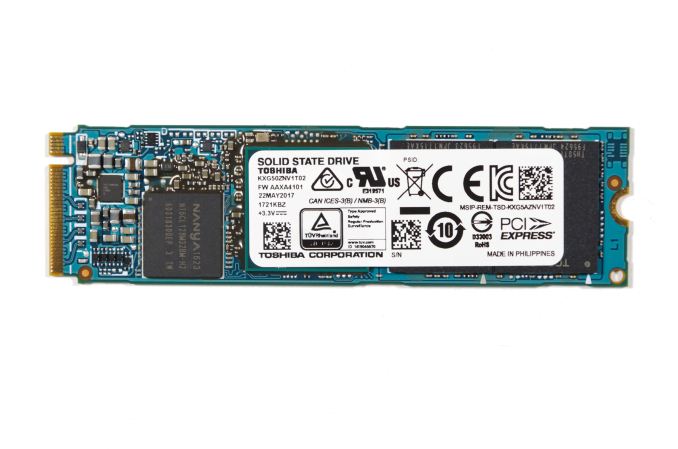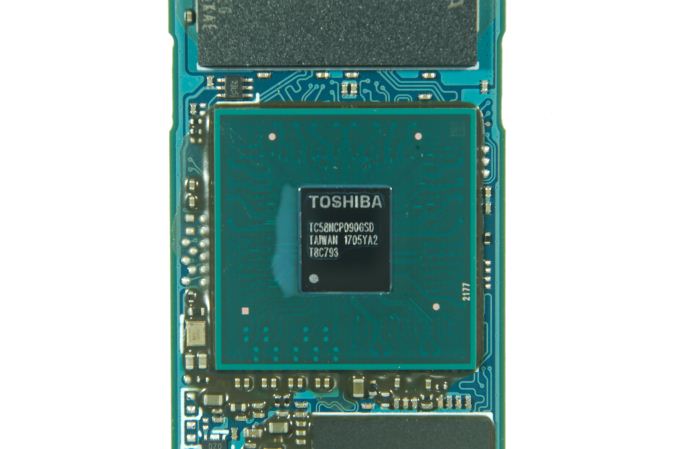The Toshiba XG5 (1TB) SSD Review
by Billy Tallis on August 3, 2017 9:01 AM EST
For several years, 3D NAND flash memory has promised to bring improvements to the performance, endurance and cost of SSDs. Samsung was the first to deliver 3D NAND and they have dominated the market ever since with the fastest consumer SSDs and the highest capacities. Last year, Intel and Micron shipped their first generation of 3D NAND and started providing stronger competition for Samsung in a few market segments, but price improvements were forestalled by the onset of an industry-wide shortage of NAND flash memory. Meanwhile, Toshiba, Western Digital/SanDisk, and SK Hynix talked a lot about their 3D NAND technology but shipped very little. A few memory cards and smartphones last year used 3D NAND, but Toshiba's first SSD with 3D NAND didn't enter mass production until around the beginning of this year, and it was a low-volume niche product.
Toshiba's 3D NAND, now in its third generation, is finally ready for primetime. Their first SSD based on their 64-layer BiCS3 3D NAND is the XG5 client NVMe SSD for the OEM market. Using their 3D TLC NAND, the XG5 is intended as the successor to both their XG3 and XG4 SSDs, which use 15nm planar MLC and TLC respectively. The trend of replacing planar MLC with 3D TLC is widespread across all segments of the SSD market, even for high-end enterprise SSDs. The general consensus has been that the extra capacity of TLC can make up for its performance disadvantages once the switch to 3D NAND has reduced those disadvantages. In the client space, the use of SLC write caching completely eliminates the penalty to write performance provided the workload's writes fit in that cache. Overall, Toshiba's decision to make the TLC-based XG5 their high-end OEM NVMe offering is no surprise.
The XG5 was first teased by Toshiba in May and was officially announced for Computex. The XG5 seems to have been the first 64-layer 3D NAND SSD to start shipping, but since it is an OEM product working its way through the suppy chain, it is still hard for consumers to acquire. Intel launched their 64-layer 3D NAND with the SSD 545s at the end of June and it managed to be the first 64L 3D NAND with retail availability. Since then, Western Digital has also announced their first 3D NAND SSDs, Toshiba announced their first retail 3D NAND SSD, and today Toshiba is announcing the rest of their OEM client 3D NAND SSDs. SK Hynix is still pretty quiet, but otherwise the SSD industry is finally reaching the point where most products will be based on 3D NAND. Planar NAND won't disappear for quite a while, but as production of 64L 3D NAND ramps up most brands will introduce their most significant product updates in years.
| Toshiba XG5 Specifications | |||
| Capacity | 256GB | 512GB | 1024GB |
| Controller | Toshiba TC58NCP090GSD | ||
| NAND Flash | 256Gb 64L 3D TLC | 512Gb 64L 3D TLC | |
| Sequential Read | 2700 MB/s | 3000 MB/s | 3000 MB/s |
| Sequential Write | 1050 MB/s | 1050 MB/s | 2100 MB/s |
| TCG Opal Encryption | Optional | ||
| Form Factor | single-sided M.2 2280 | ||
The Toshiba XG5 is intended to ride the wave of increasing NVMe adoption by OEMs. It uses the single-sided M.2 form factor preferred for notebooks and offers capacities from 256GB to 1TB. Higher capacities would be possible using this 3D NAND, but given the current shortage they would be too expensive for most consumers. The controller supports a PCIe 3.1 x4 link and complies with version 1.2.1 of the NVMe specification. Based on the chip markings (TC58NCP090GSD) it appears to be an updated version of the controller used by the XG3 and RD400 (TC58NCP070GSB), with a switch from plastic packaging to exposed-die flip chip packaging. The die size is approximately 39mm². The only performance specifications provided are for sequential transfers, but they're pretty aggressive for a TLC-based SSD. Toshiba wants the XG5 to cover a broad portion of the OEM SSD market.
We're still in the process of rolling out our new 2017 SSD test suite to replace the 2015 test suite. Our AnandTech Storage Bench (ATSB) tests based on real-world workloads are largely unchanged though we're reporting some of the results a bit differently. Our suite of synthetic tests has been overhauled to be more streamlined and less susceptible to producing unrealistic results due to thermal throttling or SLC write caches filling up. Most of the drives that have been tested so far are PCIe SSDs, so this review does not include any SATA drives for comparison in the graphs. This review compares the 1TB Toshiba XG5 against the following competitors:
- Samsung's 1TB 960 EVO, their current retail NVMe SSD using 3D TLC NAND. Results for the MLC-based 960 PRO and 950 PRO are also included
- Toshiba's 1TB OCZ RD400, the retail counterpart to the Toshiba XG3. The RD400 uses Toshiba's 15nm planar MLC NAND.
- Western Digital's 512GB WD Black and Intel's 512GB SSD 600p These are the cheaper TLC-based NVMe SSDs already on the market. The WD Black uses SanDisk 15nm TLC and the Intel 600p uses 32-layer 3D TLC NAND.
- Plextor M8PeY 512GB and Patriot Hellfire 480GB: Two NVMe SSDs using Toshiba's 15nm planar MLC with Marvell and Phison controllers, respectively. They have generally been cheaper than Toshiba's OCZ RD400.
- The Intel SSD 750 1.2TB, the first NVMe SSD marketed to consumers.
| AnandTech 2017 SSD Testbed | |
| CPU | Intel Xeon E3 1240 v5 |
| Motherboard | ASRock Fatal1ty E3V5 Performance Gaming/OC |
| Chipset | Intel C232 |
| Memory | 4x 8GB G.SKILL Ripjaws DDR4-2400 CL15 |
| Graphics | AMD Radeon HD 5450, 1920x1200@60Hz |
| Software | Windows 10 x64, version 1703 |
| Linux kernel version 4.12, fio version 2.21 | |
- Thanks to Intel for the Xeon E3 1240 v5 CPU
- Thanks to ASRock for the E3V5 Performance Gaming/OC
- Thanks to G.SKILL for the Ripjaws DDR4-2400 RAM
- Thanks to Corsair for the RM750 power supply, Carbide 200R case, and Hydro H60 CPU cooler











28 Comments
View All Comments
Hurr Durr - Friday, August 4, 2017 - link
Honey, Samsung IS South Korea.Kristian Vättö - Thursday, August 3, 2017 - link
Look at it from the other perspective. If it wasn't for Samsung, companies like Apple, Dell, HP etc. would barely have any product to sell. The US hasn't been strong in memory for decades and even today Micron is still just a drop in the ocean from overall wafer production point of view.Samus - Thursday, August 3, 2017 - link
Indeed.Santoval - Friday, August 4, 2017 - link
I think you are swimming in conspiracy theory waters. Since there is no legal way to target Samsung specifically, the only way for what you are suggesting is by slapping heavy tariffs on South Korean imports in the US. But that is a dangerous slippery slope, since it could be the start of a global tit-for-tat tariff war. Now, I do not say that Trump is not crazy or stupid enough to not go there, but I still do not think he will do it, because hopefully cooler heads will prevail. If he does the US will be completely isolated, and since it is a major part of the global economy, the 2008 - 2010 crisis will seem like peanuts.Reflex - Thursday, August 3, 2017 - link
Don't bother asking him that, it'll just turn into conspiracy theory bullshit.Ratman6161 - Monday, August 7, 2017 - link
This is the second AT story I've read today where the comments devolved into a flame war within the first page. If everyone would just stop feeding the trolls I think things would be a lot better. As it is, the comments area is rapidly reaching uselessness.cfenton - Thursday, August 3, 2017 - link
They would have to undercut the 500GB EVO by $75-$100 and the 1TB by $100-$150, at least, to make this thing compelling. Though, to be honest, I haven't noticed a huge difference going from a BX100 to a 960 EVO in everyday performance. It's certainly better for demanding tasks, but that's not important for a lot of people.Sivar - Thursday, August 3, 2017 - link
The technical detail and comprehensiveness of this SSD review is impressive.It must have taken man weeks to put this all together.
Billy Tallis - Thursday, August 3, 2017 - link
It did take quite a while to put together the new test suite, and re-test older drives for comparison data. The Intel 750 is a particular nuisance since I only have equipment to measure one power rail at a time and the 750 uses both the 12V and 3.3V lines.Now that I have the new test suite (mostly) complete and automated as much as possible, I hope to be able to churn out reviews more quickly. There will be another SSD review going up next week while I'm at Flash Memory Summit.
Ratman6161 - Monday, August 7, 2017 - link
AT is my go to place for SSD reviews. I like the consistent testing procedures over time which really helps to do apples to apples comparisons. One thing I' would like to see though is more comparisons of different sized drives in the same brand/model family.For example I was recently shopping for an NVMe drive and Samsung has been my go to brand for a few years now for high-mid range with crucial for my more run of the mill drives. So of course I was considering the 960 EVO. The trouble was I didn't need or want to pay the price for a 1 TB model (have a 750GB MX300 for bigish storage)...the 256GB was more in my price range. But you only usually have results for the 1 TB model. Digging around on other sites I was able to determine that the 256GB model took a huge performance hit compared to the larger sizes. In the past, Samsung drives used to seem like they took less of a hit when down sizing capacity, which was another plus for the brand. I ended up with a 512 GB Evo as a good balance between price and performance...but there were a lot of guesswork and assumptions involved with that choice.
I can't be the only one out there that thinks this way?